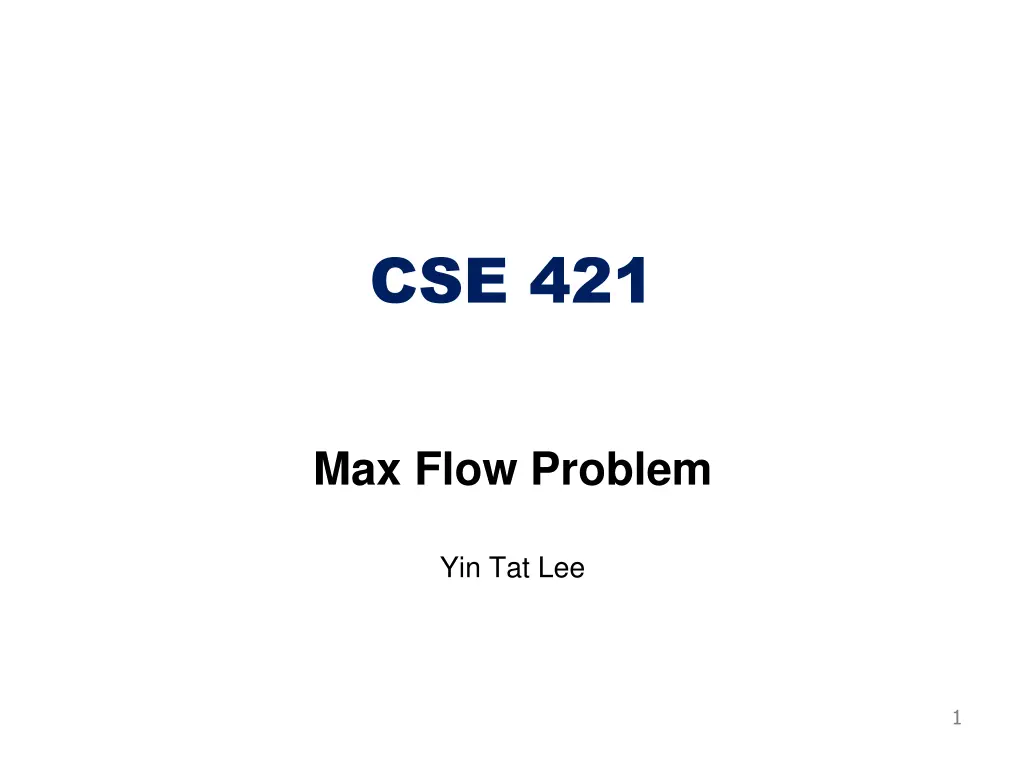
Optimizing Max Flow Problems with Augmenting Path Algorithm
Explore the concept of maximum flow problems in CSE 421, delving into definitions, s-t flows, residual graphs, augmenting path algorithm, and proof techniques for flow optimality. Dive deep into exercises and cut problems to verify maximum flow solutions.
Uploaded on | 1 Views
Download Presentation

Please find below an Image/Link to download the presentation.
The content on the website is provided AS IS for your information and personal use only. It may not be sold, licensed, or shared on other websites without obtaining consent from the author. If you encounter any issues during the download, it is possible that the publisher has removed the file from their server.
You are allowed to download the files provided on this website for personal or commercial use, subject to the condition that they are used lawfully. All files are the property of their respective owners.
The content on the website is provided AS IS for your information and personal use only. It may not be sold, licensed, or shared on other websites without obtaining consent from the author.
E N D
Presentation Transcript
CSE 421 Max Flow Problem Yin Tat Lee 1
Last Lecture: s-t Flows Def. An s-t flow is a function that satisfies: For each ? ?:0 ? ? ?(?) For each ? ? {?,?}: ? in to ??(?) = ? out of ??(?) (conservation) (capacity) Def. The value of a flow f is: ? ? = ? out of ??(?) 0 9 2 5 4 0 0 10 15 15 0 10 4 4 0 5 4 4 8 10 s 3 6 t 0 0 0 15 4 6 0 10 capacity flow 15 0 Value = 4 0 30 2 4 7
Last Lecture: Residual Graph capacity Original edge: e = (u, v) E. Flow f(e), capacity c(e). Residual edge. "Undo" flow sent. e = (u, v) and eR = (v, u). Residual capacity: u v 17 6 flow residual capacity u v 11 ??? = ? ? ? ? ?? ? ? ? ? 6 ?? ?? ? residual capacity Residual graph: Gf = (V, Ef ). Residual edges with positive residual capacity. ?? = ? ? ? < ? ? {??: ?(?) > 0}. 3
Last Lecture: Augmenting Path Algorithm Augment(f, c, P) { b bottleneck(P) foreach e P { if (e E) f(e) else f(eR) } return f } Smallest capacity edge on P f(e) + b f(e) - b Forward edge Reverse edge Ford-Fulkerson(G, s, t, c) { foreach e E f(e) Gf residual graph 0 while (there exists augmenting path P) { f Augment(f, c, P) update Gf } return f } How to check if a flow is maximum Question: 4
Outline Discuss how to prove a flow is optimal Introduce it as a new problem Relate two problems Prove correctness of augmenting path Some exercise 5
Maximum s-t Flow Problem Exercise: Is this a maximum flow? 9 9 2 5 10 9 1 10 15 15 0 10 0 4 4 5 9 8 8 10 s 3 6 t 4 10 0 15 4 6 0 10 capacity flow 15 14 Value = 28 14 30 4 7 We can verify a maxflow via a cut. 6
Minimum s-t Cut Problem Given a directed graph G = (V, E) = directed graph and two distinguished nodes: s = source, t = sink. Suppose each directed edge e has a nonnegative capacity ?(?) Goal: Find a cut separating ?,? that cuts the minimum capacity of edges. 2 9 5 10 15 15 10 4 source sink 5 8 10 s 3 6 t 15 4 6 10 15 capacity 30 4 7 7
s-t cuts Def. An s-t cut is a partition (A, B) of V with s A and t B. Def. The capacity of a cut (A, B): ??? ?,? = ?,? :? ?,? ??(?,?) ???????? = 10 + 5 + 15 = 30 9 2 5 10 15 15 10 4 5 8 10 s 3 6 t A 15 4 6 10 15 30 8 4 7
s-t cuts Def. An s-t cut is a partition (A, B) of V with s A and t B. Def. The capacity of a cut (A, B): ??? ?,? = ?,? :? ?,? ??(?,?) ???????? = 9 + 15 + 8 + 30 = 62 9 2 5 10 15 15 10 4 5 8 10 s 3 6 t A 15 4 6 10 15 30 9 4 7
Minimum s-t Cut Problem Given a directed graph G = (V, E) = directed graph and two distinguished nodes: s = source, t = sink. Suppose each directed edge e has a nonnegative capacity ?(?) Goal: Find a s-t cut of minimum capacity 9 2 5 ???????? = 10 + 8 + 10 = 28 10 15 15 10 4 source sink 5 8 10 s 3 6 t 15 4 6 10 15 capacity 30 4 7 10
Soviet Rail Network Unclassified on May 21, 1999.
Outline Discuss how to prove a flow is optimal via min s-t cut problem Relate two problems Prove correctness of augmenting path Some exercise 12
Flows and Cuts Flow value lemma. Let f be any flow, and let (A, B) be any s-t cut. Then, the net flow sent across the cut is equal to the amount leaving s. ? ? ? ? = ?(?) ? out of ? ? in to ? 6 9 2 5 10 6 0 10 15 15 0 10 4 4 3 5 8 8 8 10 s 3 6 t 1 10 0 15 4 6 0 10 capacity flow 15 11 Value = 24 11 30 13 4 7
Proof of Flow value Lemma Flow value lemma. Let f be any flow, and let (A, B) be any s-t cut. Then, the net flow sent across the cut is equal to the amount leaving s. ? ? ? ? = ?(?) ? out of ? ? in to ? Proof. ? ? = ?(?) ? out of ? = ? ? ?(?) By conservation of flow, all terms except v=s are 0 ? ? ? out of ? ? in to ? All contributions due to internal edges cancel out = ? ? ?(?) ? out of ? ? in to ? 14
Weak Duality of Flows and Cuts Weak Duality. Let f be any flow, and let (A, B) be any s-t cut. Then the value of the flow is at most the capacity of the cut. ? ? ???(?,?) v(f)=24, capacity=9+15+8+30=62 6 9 2 5 10 6 0 10 15 15 0 10 4 4 3 5 8 8 8 10 s 3 6 t 1 10 0 15 4 6 0 10 capacity flow 15 11 11 30 15 4 7
Weak Duality of Flows and Cuts Weak Duality. Let f be any flow, and let (A, B) be any s-t cut. Then the value of the flow is at most the capacity of the cut. ? ? ???(?,?) Proof. A B ? ? = ? ? ?(?) 4 ? ??? ?? ? ? ?? ?? ? 8 t 6 5 ?(?) s ? ??? ?? ? 7 6 ? ? = ???(?,?) ? ??? ?? ? 16
Certificate of Optimality Corollary: Suppose there is a s-t cut (A,B) such that ? ? = ??? ?,? Then, f is a maximum flow and (A,B) is a minimum cut. v(f)=28, cap(A,B)=28 9 2 5 10 9 1 10 15 15 0 10 0 4 4 5 9 8 8 10 s 3 6 t 4 10 0 15 4 6 0 10 capacity flow 15 14 14 17 30 4 7
Outline Discuss how to prove a flow is optimal via min s-t cut problem Relate two problems Prove correctness of augmenting path Some exercise 18
Max Flow Min Cut Theorem Augmenting path theorem. Flow f is a max flow iff there are no augmenting paths. Max-flow min-cut theorem. [Ford-Fulkerson 1956] The value of the max s-t flow is equal to the value of the min s-t cut. Proof strategy. We prove both simultaneously by showing the TFAE: (i) There exists a cut (A, B) such that v(f) = cap(A, B). (ii) Flow f is a max flow. (iii) There is no augmenting path relative to f. (i) (ii) This was the corollary to weak duality lemma. (ii) (iii) We show contrapositive. Let f be a flow. If there exists an augmenting path, then we can improve f by sending flow along that path. 19
Pf of Max Flow Min Cut Theorem (iii) => (i) No augmenting path for f => there is a cut (A,B): v(f)=cap(A,B) Let f be a flow with no augmenting paths. Let A be set of vertices reachable from s in residual graph. By definition of A, s A. By definition of f, t A. ? ? = ? ? ?(?) ? out of ? ? in to ? = ? ? ? out of ? = ???(?,?) 20
Running Time Assumption. All capacities are integers between 1 and C. Invariant. Every flow value ?(?) and every residual capacities ?? (?) remains an integer throughout the algorithm. Theorem. The algorithm terminates in at most ?(? ) ?? iterations, if ? is optimal flow. Pf. Each augmentation increase value by at least 1. Corollary. If C = 1, Ford-Fulkerson runs in O(mn) time. Integrality theorem. If all capacities are integers, then there exists a max flow f for which every flow value f(e) is an integer. Pf. Since algorithm terminates, theorem follows from invariant. 21
Summary Max-flow min-cut theorem. The value of the max s-t flow is equal to the value of the min s-t cut. Many optimization problems has two versions: Maximum version (finding the instance) Minimum version (finding the upper bound) One problem is primal and one problem is dual. instance Upper bound Optimum 22
Outline Discuss how to prove a flow is optimal via min s-t cut problem Relate two problems Prove correctness of augmenting path Some exercise 23
Exercise 2: Residual Graph One day, Sally comes up with a following linear time algorithm: For any directed graph with ? edges and ? vertices, it can compute a ? ? flow with flow value is at least of maximum flow value . Show how to use this to find exact maximum flow in ?(?log?) time where ? is the maximum flow value. 25
Exercise 3: Capacity Recall that augmenting path takes ?(??) time. Shows how to solve maximum flow in ?(??log?). 26






















